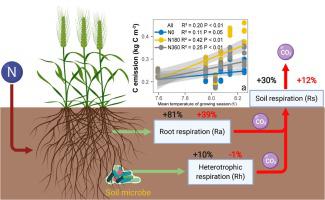Our official English website, www.x-mol.net, welcomes your feedback! (Note: you will need to create a separate account there.)
Response of soil respiration to nitrogen fertilization: Evidence from a 6-year field study of croplands
Geoderma ( IF 6.1 ) Pub Date : 2021-02-01 , DOI: 10.1016/j.geoderma.2020.114829 Weiming Yan , Yangquanwei Zhong , Jin Liu , Zhouping Shangguan
Geoderma ( IF 6.1 ) Pub Date : 2021-02-01 , DOI: 10.1016/j.geoderma.2020.114829 Weiming Yan , Yangquanwei Zhong , Jin Liu , Zhouping Shangguan

|
Abstract Agroecosystems receive large amounts of nitrogen (N), which can have a profound impact on soil respiration (Rs). Although Rs is the largest carbon dioxide (CO2) flux from terrestrial ecosystems to the atmosphere, the potential effects of N fertilization on Rs and its components (heterotrophic respiration (Rh) and autotrophic respiration (Ra)) remain controversial, and information on the impacts of N fertilization on C emission from long-term experiments is lacking. In this study, we conducted a field experiment during 6 growing seasons (2012–2018) in which we applied N fertilizer at three rates (0, 180 and 360 kg N ha−1, referred to as N0, N180 and N360, respectively) to two wheat varieties (Changhan No. 58 (CH) and Zhengmai No. 9023 (ZM)) and investigated the effects of N fertilization on Rs and its components by continuous half-hourly observations. We found that over the 6 growing seasons, N180 and N360 increased the mean growing season soil C emission by 29.7% and 11.6%, respectively, due to the increased C emission through Ra under fertilization, which was related to an increased leaf area index (LAI) and canopy photosynthesis (Pn). Significant seasonal variations in the Rs rate were observed; both Rh and Ra contributed to these variations, and the variations were significantly correlated with both soil and air temperature and plant-related traits (LAI and canopy Pn). In addition, the C emission through Rs during the growing season increased throughout the experiment, mainly because of an increase in C emissions through Rh that was caused by increasing temperature during the observation period due to climate change at the experimental site. However, C emission through Rs increased relatively rapidly under the N180 treatment due to the increased Rh throughout the experiment. Furthermore, interaction effects of soil moisture and temperature on the Rs rate and its components were also observed. Overall, our findings highlight the significance of N fertilization in term of soil C emission and its feedback under global warming in agroecosystems.
中文翻译:

土壤呼吸对施氮肥的响应:来自 6 年农田田间研究的证据
摘要 农业生态系统接收大量的氮 (N),这会对土壤呼吸 (Rs) 产生深远的影响。尽管 Rs 是从陆地生态系统到大气的最大二氧化碳 (CO2) 通量,但施氮对 Rs 及其成分(异养呼吸 (Rh) 和自养呼吸 (Ra))的潜在影响仍然存在争议,有关影响的信息长期实验中缺乏施氮对碳排放的影响。在本研究中,我们在 6 个生长季节(2012-2018 年)进行了田间试验,其中我们以三种比率(0、180 和 360 kg N ha-1,分别称为 N0、N180 和 N360)施氮肥到两个小麦品种(长汉58(CH)和郑麦1号)9023 (ZM)) 并通过连续半小时观察研究施氮对 Rs 及其成分的影响。我们发现,在 6 个生长季节,N180 和 N360 使平均生长季节土壤 C 排放分别增加了 29.7% 和 11.6%,这是由于施肥条件下通过 Ra 的 C 排放增加,这与叶面积指数增加有关( LAI) 和冠层光合作用 (Pn)。观察到 Rs 率的显着季节性变化;Rh 和 Ra 都促成了这些变化,并且这些变化与土壤和空气温度以及植物相关性状(LAI 和冠层 Pn)显着相关。此外,在整个实验过程中,生长季节通过 Rs 的 C 排放增加,主要是由于实验地点气候变化导致观测期间温度升高导致通过Rh的C排放增加。然而,由于整个实验中 Rh 的增加,在 N180 处理下,通过 Rs 的 C 发射增加相对较快。此外,还观察到土壤水分和温度对 Rs 速率及其成分的相互作用影响。总体而言,我们的研究结果强调了施氮对土壤碳排放的重要性及其在全球变暖下农业生态系统的反馈。还观察到土壤水分和温度对 Rs 速率及其成分的相互作用影响。总体而言,我们的研究结果强调了施氮对土壤碳排放的重要性及其在全球变暖下农业生态系统的反馈。还观察到土壤水分和温度对 Rs 速率及其成分的相互作用影响。总体而言,我们的研究结果强调了施氮对土壤碳排放的重要性及其在全球变暖下农业生态系统的反馈。
更新日期:2021-02-01
中文翻译:

土壤呼吸对施氮肥的响应:来自 6 年农田田间研究的证据
摘要 农业生态系统接收大量的氮 (N),这会对土壤呼吸 (Rs) 产生深远的影响。尽管 Rs 是从陆地生态系统到大气的最大二氧化碳 (CO2) 通量,但施氮对 Rs 及其成分(异养呼吸 (Rh) 和自养呼吸 (Ra))的潜在影响仍然存在争议,有关影响的信息长期实验中缺乏施氮对碳排放的影响。在本研究中,我们在 6 个生长季节(2012-2018 年)进行了田间试验,其中我们以三种比率(0、180 和 360 kg N ha-1,分别称为 N0、N180 和 N360)施氮肥到两个小麦品种(长汉58(CH)和郑麦1号)9023 (ZM)) 并通过连续半小时观察研究施氮对 Rs 及其成分的影响。我们发现,在 6 个生长季节,N180 和 N360 使平均生长季节土壤 C 排放分别增加了 29.7% 和 11.6%,这是由于施肥条件下通过 Ra 的 C 排放增加,这与叶面积指数增加有关( LAI) 和冠层光合作用 (Pn)。观察到 Rs 率的显着季节性变化;Rh 和 Ra 都促成了这些变化,并且这些变化与土壤和空气温度以及植物相关性状(LAI 和冠层 Pn)显着相关。此外,在整个实验过程中,生长季节通过 Rs 的 C 排放增加,主要是由于实验地点气候变化导致观测期间温度升高导致通过Rh的C排放增加。然而,由于整个实验中 Rh 的增加,在 N180 处理下,通过 Rs 的 C 发射增加相对较快。此外,还观察到土壤水分和温度对 Rs 速率及其成分的相互作用影响。总体而言,我们的研究结果强调了施氮对土壤碳排放的重要性及其在全球变暖下农业生态系统的反馈。还观察到土壤水分和温度对 Rs 速率及其成分的相互作用影响。总体而言,我们的研究结果强调了施氮对土壤碳排放的重要性及其在全球变暖下农业生态系统的反馈。还观察到土壤水分和温度对 Rs 速率及其成分的相互作用影响。总体而言,我们的研究结果强调了施氮对土壤碳排放的重要性及其在全球变暖下农业生态系统的反馈。



























 京公网安备 11010802027423号
京公网安备 11010802027423号